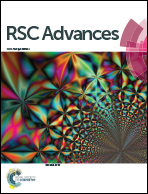A facile method to fabricate carbon nanostructures via the self-assembly of polyacrylonitrile/poly(methyl methacrylate-b-polyacrylonitrile) AB/B′ type block copolymer/homopolymer blends
Abstract
The self-assembly and high temperature behavior of AB/B′ type block copolymer/homopolymer blends containing polyacrylonitrile (PAN) polymers were studied for the first time. Here, microphase separated nanostructures were formed in the poly(methyl methacrylate-b-polyacrylonitrile) (PMMAN) block copolymer and their blends with homopolymer PAN at various blend ratios. Additionally, these nanostructures were transformed into porous carbon nanostructures by sacrificing PMMA blocks via pyrolysis. Spherical and worm like morphologies were observed in both TEM and AFM images at different compositions. The thermal and phase behavior examinations showed good compatibility between the blend components in all studied compositions. The PAN homopolymer (B′) with a comparatively higher molecular weight than the corresponding block (B) of the block copolymer is expected to exhibit ‘dry brush’ behavior in this AB/B′ type system. This study provides a basic understanding of the miscibility and phase separation in the PMMAN/PAN system, which is important in the nanostructure formation of bulk PAN based materials with the help of block copolymers to develop advanced functional materials.


 Please wait while we load your content...
Please wait while we load your content...